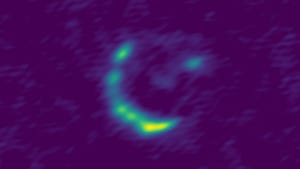
Scientists Hunt Down Mysterious 'Invisible Galaxy' From Early Universe - CNET
How do you describe a galaxy that doesn’t want to be seen? You break out a cosmic magnifying glass.
A research team led by astrophysics doctoral student Marika Giulietti of the Scuola Internazionale Superiore di Studi Avanzati (Sissa) in Italy published a study on an “very special” galaxy in The Astrophysical Journal this month. In a statement on Tuesday, Sissa described it as a “mysterious and very distant object” and “so dark that it is almost invisible, even to highly sophisticated instruments.” Intriguing.
The galaxy dates back to just 2 billion years after the Big Bang, which scientists estimate happened around 13.8 billion years ago. To get a better understanding of the galaxy, the team called on a technique known as gravitational lensing that uses certain massive celestial objects, such as clusters of galaxies, like giant lenses to help magnify what’s behind them. The Atacama Large Millimeter/submillimeter Array (ALMA) telescope in Chile provided the observations.
ALMA clued astronomers into previously unknown features of the hard-to-study galaxy, which is rich in gas and dust. “Our analysis showed that this object is very compact, presumably young and forming stars at an extremely high rate,” Giuletti said.
The galaxy has been incredibly elusive for a host of reasons. It’s very distant. It’s compact. There’s a whole lot of interstellar dust obscuring our view of it. This is one of the reasons the James Webb Space Telescope is such a big deal. Its infrared eyes let it see through thick veils of dust and peer into immensely faraway regions of our universe. The JWST hasn’t yet studied the invisible galaxy, though “in the future, the James Webb Space Telescope will reveal much more about this galaxy, something that only it can do at the moment,” Giulietti said.
In 2019, ALMA delivered the deets on another distant invisible galaxy — one that turned out to be a “massive monster.” Shining light on tricky celestial objects like these helps scientists better understand galaxy formation and evolution. Astronomers are cracking open these windows into the early universe, and they’ll be opening even wider as the JWST gets to work breaking through all that interstellar dust.



